#fuath
Text

some minions
#ff14#ffxiv#carbuncle#chocobo#moogle#mandragora#paissa#korpokkur#wee ea#serpent of ronka#sand fox#salt and pepper seal#grebuloff#sylph#namazu#fuath#shoebill#leafman#starbird#shalloweye#giant beaver#water imp#weatherproof gaelicat#im not tagging nero sorry
120 notes
·
View notes
Text
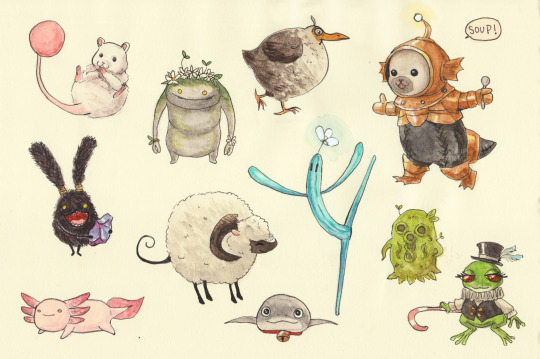
dios mio....las creaturas....
#my art#ffxiv#final fantasy 14#silkie#goobbue#spriggan#karakul#lunatender#namazu#grebuloff#fuath#animals#watercolor#cute#watercolour
33 notes
·
View notes
Text
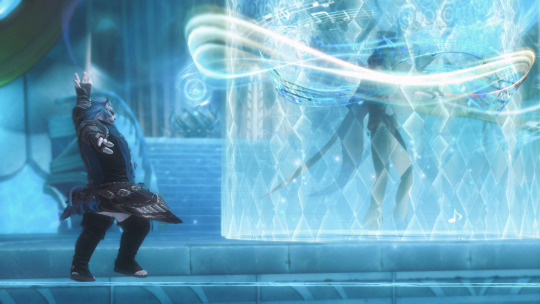
hrothtober day 6 - balance
fool's tightrope
#ffxiv#final fantasy xiv#screencap#gpose#hrothgar#fuath#aenc thon#hrothtober#my gposes#posts by me#koel (oc)#god taking this was a massive pain lmao#there's such a tiny window of time to be able to do it while the mechanic is going#and my connection briefly died when i was doing it the first time#so i had to run the entire dungeon again just to get here
11 notes
·
View notes
Text
What Are Fuath?

Fuathan (Fuath singular) have two different meanings associated with the name.
For one meaning, the name represents one singular type of creature. This creature has the shape of a man, but webbed hands and feet and a golden mane, and was popularized by folklorist John Francis Campbell in his book Popular Tales of the West Highlands.
“From all these it appears that the Fuath in Sutherland is a water spirit; that there are males and females; that they have web-feet, yellow hair, green dresses, tails, manes, and no noses ; that they marry men, and are killed by light, and hurt with steel weapons; that in crossing a stream they become restless.
From the following stories it appears that they are hairy, have bare skin on their faces, and have two large round eyes.”
Popular Tales of the West Highlands” by John Francis Campbell (1862)
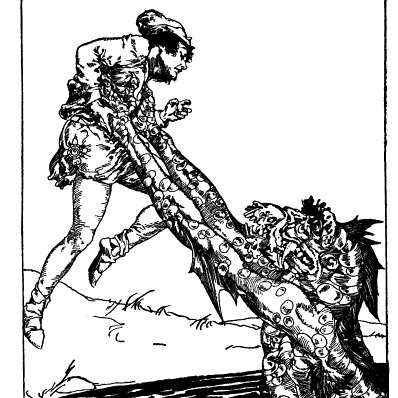
(A “fua” of the river grabs hold of a human.—Illust. Willy Pogany. Colum, Padraic (1916). King of Ireland’s son)
The second, and slightly more popular meaning, is that word as a category for several different types of water-type creatures with evil intent.
“Fuath: a spectre, a kelpie, a demon, a water-fiend frequenting glens, rivers, and waterfalls.”
Carmina Gadelica, Volume 2, by Alexander Carmicheal, [1900]
All it takes to be placed in the category is to be a water-type with evil intent; the hint of which is actually right in the name, which means “aversion,” or “hatred.”
The major differences to these meanings even caused a bit of debate between folklore writers.
“The attributes of the Fuath are different in different tales, and Mr. Campbell (Tales of the West Highlands, ii. 191) has fallen into the error of conjoining attributes ascribed in several stories, and representing the Fuath as a water spirit, having web-feet, tail, mane, etc.”
Witchcraft & Second Sight in the Highlands & Islands of Scotland by John Gregorson Campbell (1902)
Going by the second meaning, everything from a kelpie to certain water sprites may fall under the “fuath” category. In this way, it can be helpful to describe a creature in a story without knowing the exactly type. For example, if you say you were attacked by a fuath, people would know you mean an evil water-type creature.
In many stories, it is common for a person to be attacked by a fuagh, only for their dog to leap to protect them. In some stories, the dog wins but loses all of its hair.
“The dog at last disposed of the Vaugh , but he lost all his hair in the scuffle . The poacher became grey from terror in a single night , and we have reason to believe he did not again visit the pools of the Shin after dusk for any illicit purposes.”
THE VAUGH , THE POACHER , AND THE DOG from The Folklore Journal, Volume 6; Volume 21 By Folklore Society (Great Britain): The Folklore of Southerlandshire
Sadly, it is common for the dog to die the next day in stories.
Like with most fairies, they are affected by iron, but interestingly, some area also harmed by sunlight.
“One of John Ray Bethune’s forbears, who lived at Inveran, laid a bet that he would seize the kelpie of Moulinna Vaugha, or Moulinna Glannan, and bring her bound to the inn at Inveran.
He procured a brown , right-sided maned horse, and a brown black-muzzled dog, and by the help of the latter, having secured the Vaugh, he tied her on the horse behind him, and galloped away. She was very fierce, but he kept her quiet by pinning her down with an awl and a needle .
Crossing the burn at the further side of Loch Migdall, she became so restless that he stuck the shoemaker’s and the tailor’s weapons into her with great violence .
She cried out, “Och ! och ! cur anum am minme crourm ; L ‘ cum asum au ‘ hail chiul rouach,” which is, being interpreted,
“Pierce me with the crooked awl, but keep that small sharp needle ont of me.”
When he reached the clachan of Inveran, where his companions were anxiously waiting for him, he called out to them to come out and see the Vaugh. Then they came out, with lights, but as the light fell upon her she dropped off, and fell to earth, like the remains of a fallen star, a small lump of jelly.
[ These jellies are often seen on the moors , and are called “dropped stars.” ]
The Folklore Journal, Volume 6; Volume 21 By Folklore Society (Great Britain): The Folklore of Southerlandshire
So, putting this all bluntly, a fuath is commonly a category of water fairies that have a tendency to be evil, but some people use it to describe a single creature type.
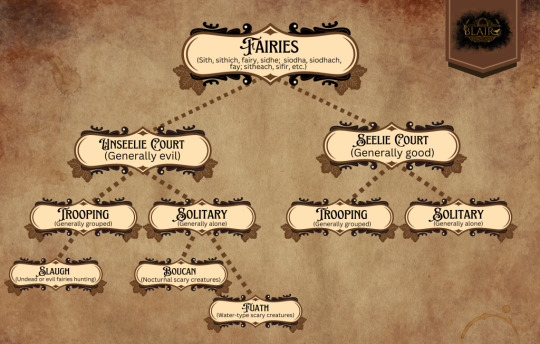
#fuath#fauth#scottishfolklore#scottish folklore#scottish myths#scottish mythology#FairyBasics#fairybasics#FairyTypes#fairytypes#fae#faerie#fae folk#fairies#fairy#unseelie#unseeliecourt#ScottishFolkoreBasics#MiscScottishFairies#WaterTypeFairies
31 notes
·
View notes
Text
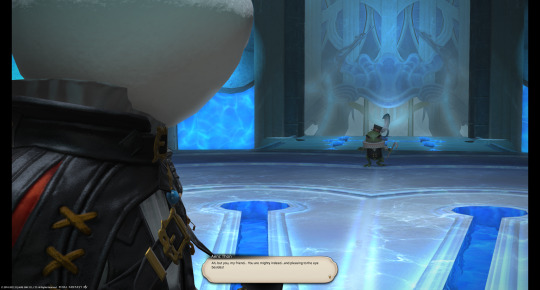


my shadowbringers replay is going well
26 notes
·
View notes
Text
Me: Goodness, Il Mheg is so pretty. And just look at how clear the water is!
Also me: If the Fuath came from the souls of the drowned, and that city under water is what’s left of the Capitol of Voeburt…oh…oh no…
#shadowbringers spoilers#Shadowbringers#il mheg#Fuath#FFXIV#FFXIV lore#I feel so bad for the Fuath now#final fantasy xiv
7 notes
·
View notes
Text

Another Scottish one, the Glaistig: in some tales she protects herders and their families, in others she drinks all your blood, so who’s to say #HellaWieners
#halloween#hellawieners#hella wieners#halloween 2022#glaistig#fuath#celtic mythology#celtic folklore#scottish mythology#scottish folklore
5 notes
·
View notes
Text









Brave police J-Decker sensory board part 7
ShadowMaru🥷🐾
Shadowsmar!!!:D
Silly little ninja wuf wuf, who's also MY emo princess girlfriend<3
#sensory#sensory board#stim gifs#purple stim#brave police j decker#bpjd#bpjd sensory board#shadowmaru#brave police j decker shadowmaru#red stim#gold stim#my bbg is shadowsmaru#Is fuath liom tú sinita#shadowsmar is irish!?#ourple man (wuf wuf)
47 notes
·
View notes
Note
HII!!
How has your day been
HIII!!!
I'm actually so good my Irish teacher wasn't in mar tá sé seachtaine na Gaeilge
7 notes
·
View notes
Text
Its really funny when you feel yourself flanderizing ur own character
Like, Entlona's Depths Thing started off minor- she was testy and uncomfortable at the extreme depths in the binding coils. But it's become more and more of a Thing for her. Entlona is someone who really tries to face her fear head on, learn as much as she can so she can find ways to counteract it, or gain a new perspective, or just get too used to it to be scared the same way. Her ultimate fear is loss of control, so just the feeling of a panic response is something she hates. But depths...she can't nerd her way out of this one, there's very little you can do against the sea- its the ultimate uncontrollable thing, right? And feeling trapped as well- she"s not claustrophobic (growing up on ships she couldn't let herself be), but the idea of the pressure pushing down on her gives her nightmares by itself. Even the kojin's blessing hasn't helped much, because there's a lot of unknowns and no way to test them- what depths is it effective until? Does it help with decompression sickness? Sure she can breath but will her lungs just pop? She's such a stoic its fun to find strings to pull at to unravel her a bit, you know?
#ffxiv#entlona eifasaldwyn#as u can imagine shes not a fan of the fuath#this is also something she tends to be very fussy about @mikana and lyse and alisaie#she is always getting on them not to take the blessing for granted and still take safety measures ect ect#in general entlona ks the type to face her fears head on purely bc the feeling of panicking is something she hates#so she tries to study them and demistify them and prepare#except. theres only So Much You Can Do with the ocean aint there
2 notes
·
View notes
Text
abair liom é: fuck árdteist harmony
2 notes
·
View notes
Text
Beithir | Scottish Folklore

Within the highlands of Scotland, there was once folklore of a type of great serpent called Beithir.
"Beithir, adder, serpent, thunderbolt, lightning, a destructive deity dwelling in caves, corries, and mountain fastnesses."
Carmina Gadelica, Volume 2, by Alexander Carmicheal, [1900]
It was one of the fuath, making it very dangerous, and was so large that it could eat several horses or cattle in one meal.
It preferred to lurk in dark places, such as caves, and had a bite with venom.
"Beithir was a venomous and destructive creature, who lived in dark caves and corries in the mountains. "
Highland Mythology by Watson, E. C. (1908)
It was not one specific creature by the name, but instead a species.
Some were said to be killed, such as the one of Islay. It was first tempted by barrels of meat which were hiding spikes to be swallowed, then it was finished off by cannon-fire.
“The big beast of Scanlastle in Islay was one of this kind. It devoured seven horses on its way to Loch-in-daal.
A ship was lying at anchor in the loch at the time, and a line of barrels filled with deadly spikes, and with pieces of flesh laid upon them, was placed from the shore to the ship.
Tempted by the flesh, the ‘ loathly worm ‘ made its way out on the barrels and was killed by the spikes and cannon.”
Superstitions of the Highlands & Islands of Scotland by John Gregorson Campbell (1900)
There is one other tale in Popular Tales of the West Highlands by J. F. Campbell [1890], that mentions the Beithir. In this story, a boy is cursed by a shirt made of the skin of a Beithir.
The daughter of a wise woman falls in love with the boy, and agrees to several sacrifices in order to save him. So, the mother puts the boy into a cauldron with specific herbs, and the beithir transforms from a shirt, back into a serpant, and attacks the girl(as was expected). The girl cuts the beithir off (and her breast with it) and so the boy is freed from the curse.
They marry, she get’s a golden breast, then they go on adventures together.
Old Macdonald, travelling tinker, told me a long story, of which one scene represented an incantation more vividly to me than anything I have ever read or heard.
“There was a king and a knight, as there was and will be, and as grows the fir tree, some of it crooked and some of it straight, and he was a king of Eirinn,” said the old tinker, and then came a wicked stepmother, who was incited to evil by a wicked henwife.
The son of the first queen was at school with twelve comrades, and they used to play at shinny every day with silver shinnies and a golden ball. The henwife, for certain curious rewards, gave the stepdame a magic shirt, and she sent it to her step-son, ” Sheen Billy,” and persuaded him to put it on ; he refused at first, but complied at last, and the shirt was a beithir (great snake) about his neck.
Then he was enchanted and under spells, and all manner of adventures followed but at last he came to the house of a wise woman who had a beautiful daughter, who fell in love with the enchanted prince, and said she must and would have him.
“It will cost thee much sorrow,” said the mother.
“I care not,” said the girl, “I must have him.”
“It will cost thee thy hair.”
“I care not.”
“It will cost thee thy right breast.”
“I care not if it should cost me my life,” said the girl.
And the old woman agreed to help her to her will.
A caldron was prepared and filled with plants and the king’s son was put into it stripped to the magic shirt, and the girl was stripped to the waist. And the mother stood by with a great knife, which she gave to her daughter.
Then the king’s son was put down in the caldron, and the great serpent, which appeared to be a shirt about his neck, changed into its own form, and sprang on the girl and fastened on her; and she cut away the hold, and the king’s son was freed from the spells.
Then they were married, and a golden breast was made for the lady. And then they went through more adventures, which I do not well remember, and which the old tinker’s son vainly strove to repeat in August, 1860, for he is far behind his father in the telling of old Highland tales.
Popular Tales of the West Highlands by J. F. Campbell [1890]
#folklore#scottish#scottish mythology#scottish folklore#scottishfolklore#FairyTypes#fuath#mythological creature#myth#mythology#myths#fairy#Beithir#ScottishDragonsAndSuch#MiscScottishFairies
10 notes
·
View notes
Photo

yeah I’m sure there’s not going to be any lasting trauma here for my wol who is fucking terrified of drowning AND immediately thinks of the impending deaths of her loved ones in Ishgard while talking about the fate of this kingdom
#shadowbringers tag#jfc#fuck u fuath#gee yloise how come mom let you have two tanks haunting you#*i maintain that fray is an honorary tank even though fray is very clearly a healer
11 notes
·
View notes
Text
Quiero poder hablar español pero estoy muy muy estupido🫶🫶
#i hate oliver cromwell#i hate pope francis#i hate king louis xiv#i hate dolphins#odio oliver cromwell#tá an fuath dearg agam ar oliver cromwell#is fuath liom louis xiv#odio louis xiv#spanish#i cannot speak spanish
2 notes
·
View notes
Text
In My Highlands Era, Please Dont Ask Why
(I did however just get accepted to a field school in IRELAND. if I get scholarships, that does mean I'll finally make it to Ireland just as my hyperfixation switches to Scotland... damn in Autism)
#folklore#you can't just have the Fuath (the creature I mean) and expect me not to show up#Glashtyn too like good lord! im gay
0 notes